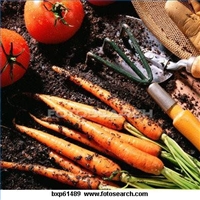Planting a Vegetable Garden
By Jos Van Hage
 Vegetable gardening is becoming a huge trend and I’ve noticed that even locally many people want to grow their own vegetables.Nothing beats the taste and freshness of eating home grown produce.
Vegetable gardening is becoming a huge trend and I’ve noticed that even locally many people want to grow their own vegetables.Nothing beats the taste and freshness of eating home grown produce.
If you are thinking of putting in a vegetable garden there is several things to consider first before going ahead.
Location is an important factor in choosing the right site for the garden. Vegetables need a daily minimum of 6 hours of direct sunlight but if they receive more sunlight they will be tastier and the yields will be larger. Stay away from existing trees and shrubs as their roots will compete for nutrients with the vegetables in the garden.
Soil is a key ingredient when planting a garden as vegetables requires a soil that is well drained, rich, and a balanced pH of about 6.5-7. It is a good idea to do a soil test and check the pH and the fertility of the soil. Soil can be amended by using compost, aged manure, fertilizer, sand or you may want to bring in new soil if the soil is very poor. Don’t till or spade the soil when it’s too wet or too dry. A good test is to pick up the soil in your hand and squeeze it into a lump. If the soil won’t form a lump it is too dry. If it forms a lump give it a poke with your other finger and if the soil remains in the clump it is too wet but if the soil crumbles it is ready to be worked.
If you have an existing lawn the sod will have to be broken down or removed. To remove the sod use a spade and cut the sod into squares dig it up and shake out the topsoil from the roots. Next you can ‘double dig’ which means digging down two spade depths into the soil and by doing this you can place the cut up sod at the very bottom of the trench. Double digging will break up the soil on the lower level as well as amend the soil on the upper level by adding compost, fertilizer, aged manure, (or sand in the case of heavy poor drained soils,) as you are digging. If you are going to power till instead of dig it is advisable to remove the sod and shake out as much of the topsoil as possible before tilling the soil, so that you don’t get those large sod clumps in the garden soil. If you choose to power till the lawn before removing the sod then the sod clumps should be raked out after you have tilled. There is alternative method of not having to worry about the sod and that is to spray the sod with the herbicide ‘Round up’ first before tilling the soil. This has to be done when the grass is active so you cannot apply Round up until you see the grass is growing. Mark the area with string that you want to convert into a garden before applying the Round up. After spraying the marked area with Round up you will have to wait for 7-10 days for the grass to turn yellow and die before tilling the soil. The herbicide ‘Round up’ does not affect the soil and so the garden can be planted whenever you are ready.
If you have very poor soil and it would be too much work to amend it, you can bring in new soil and place it over an existing lawn. It is important to use a good quality soil so do some research and find out what the soil consists of before purchasing it.
When you are on clay soil or have poor drainage make sure that you put a slope on the area first so that the water will drain away from the garden before going on to the next step.
To create a barrier between the new soil and the existing sod, place a thick layer of newspaper and/or leaves over the existing lawn before dumping the new soil over top of it. It should be 12-18 inches deep so that the roots can go down and root crops can grow easily. This can be a type of free form raised bed 3-4 feet wide or you can make an entire garden. In our own home garden in Pineview we have clay so we chose to bring in sandy loam and place it on top of the clay and then dug a trench around the garden allowing for all the access water to drain away. The garden is also on a slight slant going towards the trench, which helps in the drainage. This has worked very well for many years and the garden has provided countless crops for family and friends!
-Jos
Jos Van Hage owns and operates two Art Knapp Home and garden Centres in Prince George:
- Highway 16 West at Kimball road
- Highway 97 North at Northwood Pulpmill Road
Previous Story - Next Story
Return to Home








